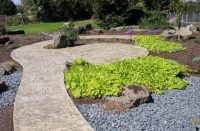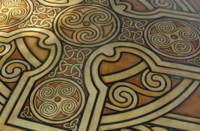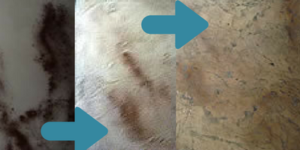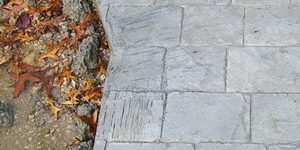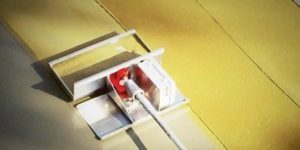Color selection for stamped and textured concrete is always at the top of the list of issues people question me about. My goal when answering questions like this has always been to try and provide good advice on color selection so no one has to come back and ask about color correction. Here is a question that recently came across my desk that is a good example of someone looking for advice on color selection for an upcoming stamped concrete project.
Question: We are going to have a 4,200-square-foot stamped concrete driveway installed. The pattern will be a large ashlar slate. What coloring method should we use and why?
The first thing that strikes me with questions like this is the lack of information the author provides me while expecting a detailed answer in return.
Details on where, when and how aside, the question remains — what are the coloring options for stamped concrete?
The two most common methods are integral color and color hardener, also known as dry-shake color. Personally, I am a color hardener fan. There is nothing wrong with integral color, and it is by far the more popular coloring option, but color hardener offers some distinct advantages.
Color hardener is a blend of cement, sands, color and, in some cases, admixtures such as wetting agents and dispersants. The two big advantages it has over other coloring options are surface strength and color intensity.
Color hardener is applied to the surface of the concrete after screeding and floating, but while the surface is still wet. The sand and cement in the color hardener increase the strength of the surface paste, increasing the overall surface strength of the concrete by as much as 1,500 psi. The strength advantage is also evident in the increased durability the extra sand and cement bring to the party.
The hardened surface is also richer in color, since all the color remains in the paste and is not diluted in the concrete. The color is more consistent, too, as any variations in the base concrete mix are never in play. Yes, there can be an issue if the concrete is chipped and the underlying gray concrete color comes shining through, but in all my years in the business I have only witnessed this on a few occasions.
The downside to color hardener is that is adds an extra step, skill is required in knowing how and when to apply it, and it can be a dusty mess if the wind is blowing or it is misapplied.
Integral color, the other coloring option, has become the hands-down favorite among stamped concrete installers in recent years, mainly because it is easy and has become readily available. When I started selling pigment in the decorative concrete industry almost 20 years ago, colored concrete was rare and very few ready-mix installers offered it, let alone promoted it. Today, larger ready-mix producers have an automated color-dispensing system and at a minimum sell and promote colored concrete. In today’s fast-paced world, ordering concrete pre-colored from the ready-mix producer has become commonplace. It’s easy and for the most part consistent.
There are also many contractors who will throw the color into the back of the ready-mix truck when it arrives on-site. If you are considering adding your own color to the truck on-site, always check with the ready-mix supplier to make sure they don’t have policies against this practice. Also, be prepared to pay extra, as some ready-mix suppliers have surcharges and fees for adding your own color.
The downside to integral color is the possibility of color inconsistency, especially on larger jobs. Since the color is added to the concrete, any inconstancies in the gray base concrete will be reflected in the final colored concrete. Batch-to-batch consistency and how the concrete is handled and placed at the job site become critical. Applying water during finishing and other poor finishing techniques are the top issues leading to color problems when integral color is used.
Color selection for stamped concrete does not stop here. Base color attained with color hardener or integral color is important, but the secondary color can be almost as important. The secondary or antiquing color is what gives stamped concrete the look of stone, tile or wood. Without secondary color, stamped concrete looks artificial and unattractive.
While base coloring options of color hardener and integral color have remained fairly constant over the last 30 years, secondary coloring options have seen some significant changes in recent years.
The most recent change has involved the use of “post-coloring systems.” These are pigment-based washes that are applied to the concrete a few days after stamping. The fundamental concept for all these systems is the same. The concrete is stamped using a clear liquid release. Then, the colored liquid is sprayed or broom-applied to the concrete. The colored wash seeks out the low areas of the stamped and textured surface, pooling in these areas. The liquid carrier evaporates, leaving the colorant behind and resulting in a naturally highlighted and fairly realistic-looking surface. Very little cleaning is required, and the process is quick and easy.
The one downside with this process is the possibility of overapplication of the post-coloring material, which can lead to premature sealer failure down the road. This process of post-coloring using pre-manufactured color wash systems has replaced older post-coloring methods using stains that require long cure times and intensive water cleanup.
Lastly, the time-tested and field-proven use of release powder is still the go-to method for post-coloring stamped concrete. Most stamped concrete craftspeople will agree that powder release provides the most realistic and consistent look. If aesthetics and long-term color durability are your primary goal, release powder is, and will continue to be, the product of choice for secondary-coloring stamped concrete. Of course, the downside to release powder remains the ever-present possibility that more of the product will end up on you and your crew than on the ground.
Note: When handling any of the powder and color products noted in this article, steps should be taken to minimize skin contact. Dust masks, gloves, long-sleeve shirts and long pants should always be worn.
